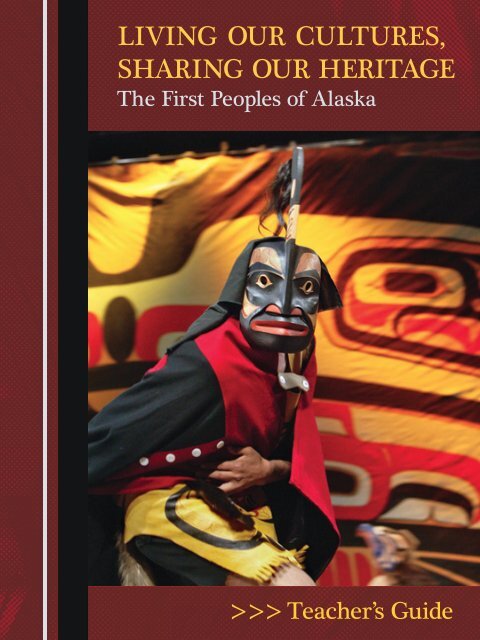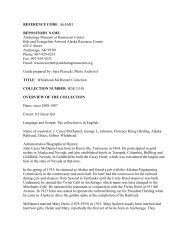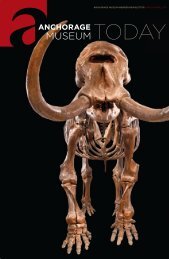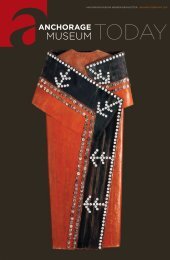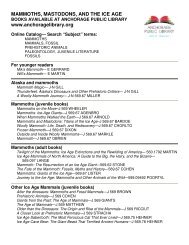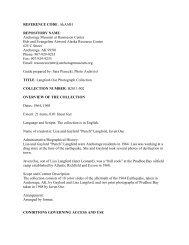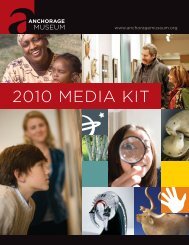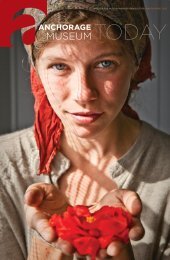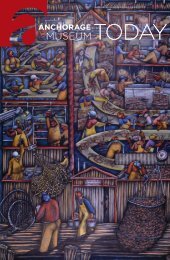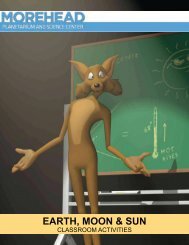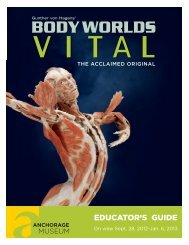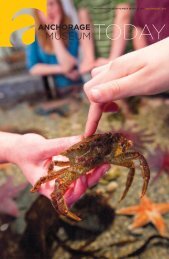Living Our Cultures, Sharing Our Heritage: The First Peoples of Alaska
Living Our Cultures, Sharing Our Heritage: The First Peoples of Alaska
Living Our Cultures, Sharing Our Heritage: The First Peoples of Alaska
Create successful ePaper yourself
Turn your PDF publications into a flip-book with our unique Google optimized e-Paper software.
<strong>Living</strong> LIVING <strong>Our</strong> OUR <strong>Cultures</strong>,<br />
CULTURES,<br />
<strong>Sharing</strong> SHARING <strong>Our</strong> OUR <strong>Heritage</strong> HERITAGE<br />
<strong>The</strong> <strong>First</strong> <strong>Peoples</strong> <strong>of</strong> <strong>Alaska</strong><br />
<strong>The</strong> <strong>First</strong> <strong>Peoples</strong> <strong>of</strong> <strong>Alaska</strong><br />
>>> Teacher’s Guide
2<br />
5<br />
8<br />
9<br />
12<br />
OVERVIEW<br />
an introduction<br />
MUSEUM<br />
the smithsonian arctic studies center<br />
WEBSITE<br />
sharing knowledge<br />
TEACHING<br />
learning about alaska native cultures<br />
RESOURCES<br />
additional publications and websites<br />
WRITTEN | Patricia H. Partnow, Ph.D.<br />
EDITED | Dr. Aron L. Crowell and Dawn D. Biddison,<br />
Smithsonian Arctic Studies Center<br />
DESIGN AND LAYOUT | Jessica Halloran<br />
EDUCATIONAL CONSULTING | Monica Garcia, Anchorage Museum<br />
ILLUSTRATIONS | John Locascio (Ralph Appelbaum Associates) and Jessica Halloran<br />
PHOTOGRAPHS | Chuck Choi; Roy Corral; D’Anne Hamilton; Bill Hess; Donald E.<br />
Hurlbert, National Museum <strong>of</strong> Natural History Imaging,<br />
Smithsonian Institution;National Museum <strong>of</strong> the American Indian<br />
Photo Services Staff; Archives, University <strong>of</strong> <strong>Alaska</strong> Fairbanks<br />
FUNDING | Rasmuson Foundation<br />
1<br />
Smithsonain Arctic Studies Center | <strong>Living</strong> <strong>Our</strong> <strong>Cultures</strong>
overview | museum | website | teaching | resources<br />
OVERVIEW<br />
For the first time, <strong>Alaska</strong>ns – and, through the <strong>Sharing</strong> Knowledge website,<br />
people all over the world – can examine, study, appreciate and learn from the<br />
astounding creations <strong>of</strong> the indigenous nous peoples <strong>of</strong> the North as<br />
represented in the Smithsonian Institution’s collections. <strong>The</strong><br />
<strong>Living</strong> <strong>Our</strong> <strong>Cultures</strong>, <strong>Sharing</strong> <strong>Our</strong> <strong>Heritage</strong>: <strong>The</strong> <strong>First</strong><br />
<strong>Peoples</strong> <strong>of</strong> <strong>Alaska</strong> exhibition produced by the<br />
Smithsonian Arctic Studies Center at the<br />
Anchorage Museum brings together some <strong>of</strong> the<br />
finest cultural objects from <strong>Alaska</strong> a and eastern<br />
Siberia, collected over 150 years by dozens <strong>of</strong><br />
collectors and scientists.<br />
This Teacher’s Guide and website <strong>of</strong>fer<br />
teachers, students, parents and lifelong long<br />
learners a virtual entry into the exhibition<br />
through a series <strong>of</strong> classroom and<br />
research activities. Each Learning Experience<br />
leads to an exploration <strong>of</strong> the cultural<br />
knowledge, beauty and ingenuity nuity<br />
that are made tangible through the Smithsonian<br />
collections, arranged in thirteen<br />
themes that cut across cultures and historic<br />
periods.<br />
<strong>The</strong> guide can be used for independentndent<br />
teaching and learning in the classroom sroom or at<br />
home. It can serve to complement a class or<br />
personal visit to the exhibition at the Anchorage<br />
Museum, <strong>of</strong>fering both pre-visit orientation<br />
activities and post-visit explorations and<br />
classroom activities.<br />
Nussix<br />
(Woman’s Knife)<br />
2<br />
Smithsonian Arctic Studies Center | <strong>Living</strong> <strong>Our</strong> <strong>Cultures</strong>
overview | museum | website | teaching | resources<br />
TARGET AUDIENCES<br />
This virtual Teacher’s Guide contains activities and resources designed<br />
specifically for middle and high school classroom settings, and can be extended<br />
to home-schoolers and lifelong learning by college students and adults as well.<br />
MIDDLE AND HIGH SCHOOL STUDENTS: You don’t need a teacher to explore<br />
and learn from the site. Click on the Teaching tab for descriptions <strong>of</strong> the thirteen<br />
Learning Experiences. Undertake independent research as your interests lead<br />
you.<br />
TEACHERS: Detailed instructions for facilitating thirteen Learning Experiences<br />
in the classroom, arranged thematically, are supplemented with links to relevant<br />
websites, assessment suggestions, and state and national standards. Each<br />
Learning Experience is designed according to the Understanding by Design<br />
(Backward Design) model. Click on the Teaching tab.<br />
PARENTS: <strong>The</strong> instructions and information at the Teaching tab work equally<br />
well for formal classrooms and home-schooling parents and their children.<br />
COLLEGE STUDENTS AND LIFELONG LEARNERS: Follow your interests and<br />
conduct your own research. Enter the website through the thirteen themes in the<br />
Teaching tab, or jump directly into descriptions and histories <strong>of</strong> the objects in the<br />
exhibit from the Website tab.<br />
3<br />
Smithsonian Arctic Studies Center | <strong>Living</strong> <strong>Our</strong> <strong>Cultures</strong>
overview | museum | website | teaching | resources<br />
WHAT’S HERE?<br />
MUSEUM TAB: Learn about the Smithsonian Arctic Studies Center and its<br />
resources. See a photographic preview and floor plan <strong>of</strong> the <strong>Living</strong> <strong>Our</strong> <strong>Cultures</strong><br />
exhibition. Learn about education programs and school visits to the Anchorage<br />
Museum.<br />
WEBSITE TAB: Get an overview and link to the <strong>Sharing</strong> Knowledge website,<br />
where you will find detailed information about the objects in the exhibition and<br />
the cultures that produced them, as well as interview transcripts about the<br />
objects’ cultural importance.<br />
TEACHING TAB: Start with a brief description <strong>of</strong> the thirteen Learning<br />
Experiences that have been designed for middle and high school students.<br />
Choose those you want to explore and find detailed teaching strategies and<br />
activity ideas, vocabulary, links to other websites, lists <strong>of</strong> materials you’ll need,<br />
assessment ideas, and <strong>Alaska</strong> and national academic and cultural standards.<br />
RESOURCES TAB: Click here for a for a list <strong>of</strong> publications, guides and websites<br />
about <strong>Alaska</strong> produced by the Arctic Studies Center and the Smithsonian. Find<br />
subject-specific print and internet resources in each Learning Experience section,<br />
as well as under the Resources tab on the <strong>Sharing</strong> Knowledge website.<br />
IN ADDITION TO THIS GUIDE . . .<br />
If possible, be sure to:<br />
<br />
<br />
exhibition as a companion to the<br />
website. <strong>The</strong> book is entitled <strong>Living</strong> <strong>Our</strong><br />
<strong>Cultures</strong>: <strong>Sharing</strong> <strong>Our</strong> <strong>Heritage</strong>: <strong>The</strong><br />
<strong>First</strong> <strong>Peoples</strong> <strong>of</strong> <strong>Alaska</strong>, edited by<br />
Crowell, Worl, Ongtooguk and<br />
Biddison (Smithsonian Books, 2010).<br />
4<br />
Smithsonian Arctic Studies Center | <strong>Living</strong> <strong>Our</strong> <strong>Cultures</strong>
| | | |<br />
overview museum website teaching resources<br />
SMITHSONIAN ARCTIC STUDIES CENTER<br />
<strong>The</strong> Smithsonian’s Arctic Studies Center, in partnership with the Anchorage Museum and a<br />
team <strong>of</strong> indigenous elders, scholars, educators and artists, has created a highly innovative multimedia<br />
exhibition that explores the vast and varied worlds <strong>of</strong> <strong>Alaska</strong>’s <strong>First</strong> <strong>Peoples</strong>. More than<br />
600 masterworks <strong>of</strong> <strong>Alaska</strong> Native art and design, all selected from historic collections at the<br />
National Museum <strong>of</strong> Natural History and National Museum <strong>of</strong> the American Indian, are<br />
presented in a visually stunning modern gallery. <strong>Living</strong> <strong>Our</strong> <strong>Cultures</strong>, <strong>Sharing</strong> <strong>Our</strong> <strong>Heritage</strong><br />
utilizes video, text, photography, sound and interactive touch-screen media to present richlylayered<br />
indigenous interpretations <strong>of</strong> the objects as well as an exciting view <strong>of</strong> contemporary<br />
<strong>Alaska</strong> Native lifeways and values. Twenty different cultures are represented overall. <strong>The</strong><br />
exhibit collection will serve as a resource for on-going study by Native artists and experts.<br />
You can visit the project website <strong>Sharing</strong> Knowledge at http://alaska.si.edu. <strong>The</strong> site includes<br />
high-resolution images and detailed information for all <strong>of</strong> the objects in the exhibition and<br />
more, as well as maps and essays on <strong>Alaska</strong> Native and eastern Siberian peoples. <strong>The</strong>re are also<br />
short films and tours providing additional in-depth information about objects and the peoples<br />
who made them.<br />
<strong>The</strong> exhibition catalog <strong>Living</strong> <strong>Our</strong> <strong>Cultures</strong>, <strong>Sharing</strong> <strong>Our</strong> <strong>Heritage</strong>: <strong>The</strong> <strong>First</strong> <strong>Peoples</strong> <strong>of</strong> <strong>Alaska</strong><br />
is available at the Museum and online, featuring over 200 illustrated objects and over<br />
275<br />
additional photographs and illustrations. After introductions to the history <strong>of</strong> the land and its<br />
peoples, universal themes are explored referencing exquisite masks, garments, basketry and<br />
carvings that embody the diverse environments and practices <strong>of</strong> their<br />
makers. Accompanied by traditional stories and personal accounts<br />
by <strong>Alaska</strong> Native elders, artists and scholars, each piece evokes<br />
both historical and contemporary meaning.<br />
Programs for the public are underway with plans<br />
to grow.<br />
Please check the Anchorage Museum website calendar for<br />
events or to learn more about school programs.<br />
<strong>The</strong> Arctic Studies Center is a federal<br />
research and education program focus-<br />
ing on peoples, history, archaeology<br />
and cultures across the circumpolar<br />
North. <strong>The</strong> Center is part <strong>of</strong> the<br />
Smithsonian Institution's National<br />
Museum <strong>of</strong> Natural History. In<br />
1994, the Center partnered with<br />
the Anchorage Museum to open<br />
an Anchorage <strong>of</strong>fice.<br />
5<br />
Smithsonian Arctic Studies Center | <strong>Living</strong> <strong>Our</strong> <strong>Cultures</strong>
| | | |<br />
overview museum website teaching resources<br />
SMITHSONIAN ARCTIC STUDIES CENTER<br />
AT THE ANCHORAGE MUSEUM<br />
In the first arrangement <strong>of</strong> its kind, the<br />
Smithsonian Institution has loaned more<br />
than 600 <strong>Alaska</strong> Native artifacts to<br />
their place <strong>of</strong> origin. <strong>The</strong>se<br />
cultural treasures are<br />
exhibited in the<br />
exhibition <strong>Living</strong><br />
<strong>Our</strong> Culture,<br />
<strong>Sharing</strong> <strong>Our</strong><br />
<strong>Heritage</strong>: <strong>The</strong><br />
<strong>First</strong> <strong>Peoples</strong> <strong>of</strong><br />
<strong>Alaska</strong>. Through<br />
contemporary<br />
images, video,<br />
audio and touchscreen<br />
interactives,<br />
this exhibition places<br />
masterworks <strong>of</strong> the<br />
past into the context <strong>of</strong><br />
people’s lives today.<br />
To contact the Arctic Studies Center:<br />
write to 625 C St, Anchorage, AK 99501<br />
email biddisond@si.edu<br />
phone 907-929-9208<br />
6<br />
Smithsonian Arctic Studies Center | <strong>Living</strong> <strong>Our</strong> <strong>Cultures</strong>
Haida<br />
Tlingit<br />
Tlingit<br />
Unangax<br />
Yup’ik<br />
Island<br />
Lawrence<br />
St.<br />
Siberian<br />
Eastern<br />
Iñupiaq<br />
Iñupiaq<br />
| | | |<br />
overview museum website teaching resources<br />
VISIT THE ANCHORAGE MUSEUM<br />
<strong>The</strong> Anchorage Museum is located in downtown Anchorage, <strong>Alaska</strong> at the corner <strong>of</strong> 7th Avenue and<br />
C Street. To find out more about museum tours, go to www.anchoragemuseum.org/visit/tours<br />
KEY<br />
Display<br />
Case<br />
Bench<br />
Website<br />
Table Access & Chairs<br />
Film<br />
Interactive<br />
Touchscreen<br />
Smithsonian Arctic Studies Center<br />
Gillam<br />
Archaeology<br />
Archaeology<br />
Laboratory<br />
Laboratory<br />
<strong>The</strong> Listening Space Space<br />
Cultural<br />
Consultation<br />
Room<br />
Community & Family<br />
Ceremony & Celebration<br />
<strong>Living</strong> from the Sea, Land, & Rivers<br />
Tsimshian<br />
Eyak<br />
/<br />
Athabascan<br />
Eyak<br />
/<br />
Athabascan<br />
Sugpiaq<br />
Yup’ik<br />
Yup’ik<br />
Introductory Film<br />
Learning Gottstein<br />
Learning Center<br />
Center<br />
SCHOOL GROUPS: Now, more than ever, the Anchorage Museum is a multicultural and<br />
interdisciplinary field trip destination – bringing the best <strong>of</strong> <strong>Alaska</strong> to the world and the best <strong>of</strong> the<br />
world to <strong>Alaska</strong>. Through focused experiential learning combining art, history and science, teachers<br />
and students engage their senses and exchange a variety <strong>of</strong> Western and Indigenous ideas. <strong>The</strong><br />
Education Department has developed a rich slate <strong>of</strong> art, history and science programs. Offerings<br />
include lectures, docent-led tours, classroom investigations, hands-on student classes,<br />
demonstrations, planetarium star shows and customizable self-guided adventures.<br />
<strong>The</strong> Education Department aligns all programs and written curriculum to both the national and<br />
state standards. For more information on school programs and to download the Annual Educator<br />
Catalog, or for information on public programs, please visit the museum website at<br />
http://www.anchoragemuseum.org/learn/learn.aspx to learn more!<br />
To Contact the Anchorage Museum:<br />
write to 625 C St, Anchorage, AK 99501;<br />
phone (907) 929-9200;<br />
fax (907) 929-9290;<br />
email museum@AnchorageMuseum.org<br />
7<br />
Smithsonian Arctic Studies Center | <strong>Living</strong> <strong>Our</strong> <strong>Cultures</strong>
| |<br />
| |<br />
overview museum website teaching resources<br />
ALASKA NATIVE COLLECTIONS: SHARING KNOWLEDGE<br />
http://alaska.si.edu<br />
<strong>The</strong> <strong>Sharing</strong> Knowledge website presents the collaborative<br />
work <strong>of</strong> indigenous communities from across <strong>Alaska</strong> and<br />
eastern Siberia with the Arctic Studies Center and the Anchorage<br />
Museum. Its resources interpret the materials, techniques,<br />
cultural meanings, history and artistry represented by<br />
objects in the collections ons <strong>of</strong> the National Museum <strong>of</strong><br />
Natural History and National Museum <strong>of</strong> the<br />
American Indian. <strong>The</strong> goals <strong>of</strong> <strong>Sharing</strong><br />
Knowledge are to make the Smithsonian<br />
collections accessible to all and to support<br />
cross-cultural learning among indigenous<br />
home communities, in schools and around the<br />
world.<br />
Object records on the website – reached by browsing or<br />
searching – include edited transcripts <strong>of</strong> discussions with<br />
Native elders, artists and scholars; summaries drawn<br />
from history, anthropology and recorded oral<br />
tradition; object names in Native languages; and<br />
archival images that provide cultural context. <strong>The</strong><br />
<strong>Cultures</strong> section includes regional introductions, a<br />
map and information about contributors. <strong>The</strong><br />
Resources section <strong>of</strong>fers reading materials and<br />
web links.<br />
<strong>The</strong> <strong>Sharing</strong> Knowledge website will grow<br />
over time as more information is recorded<br />
and new contributors can be brought into the<br />
discussions. Please watch the site for updated<br />
materials and features.<br />
8<br />
Smithsonian Arctic Studies Center | <strong>Living</strong> <strong>Our</strong> <strong>Cultures</strong>
| | |<br />
|<br />
overview museum website teaching resources<br />
LEARNING EXPERIENCES:<br />
This guide presents 13 learning experiences designed for middle and high school<br />
students that will deepen and enrich their understanding <strong>of</strong> the peoples <strong>of</strong> the Far North.<br />
<strong>The</strong>y are written for teachers, but all students and life-long learners should feel free to<br />
undertake the investigations on their own or as part <strong>of</strong> an independent study.<br />
<strong>The</strong> topics are:<br />
LEARNING EXPERIENCE 1: Geographic Study <strong>of</strong> the <strong>Peoples</strong> <strong>of</strong> the North<br />
Examine the cultural map on the web site, then prepare a visual display that shows the<br />
linguistic and cultural relationships among the various peoples, then choose one<br />
cultural group to study in depth.<br />
LEARNING EXPERIENCE 2: Natural Resources and How <strong>The</strong>y Are Used<br />
Explore the clothing you wear and learn about its manufacture. Compare these<br />
processes with those used in making clothing <strong>of</strong> the North.<br />
LEARNING EXPERIENCE 3: Seasonal Knowledge, Yearly Cycles<br />
Choose one or two culture groups and search the website to find information on the<br />
objects from those cultures. Select at least one item that relates to each season, then<br />
draw a poster that shows the seasons and depicts the seasonal items you chose for the<br />
seasons.<br />
LEARNING EXPERIENCE 4: <strong>Living</strong> From the Land and Sea<br />
Explore objects on the website that were used by people <strong>of</strong> the North to hunt on both<br />
land and sea. You will learn that every successful hunt is the result <strong>of</strong> good preparation<br />
and is followed by efforts to process and preserve the food and to share it.<br />
LEARNING EXPERIENCE 5: Traveling<br />
Explore the website for information about how, where and why the peoples <strong>of</strong> the Far<br />
North traveled in pre-contact days.<br />
LEARNING EXPERIENCE 6: Northern Clothing: Designed for Extremes<br />
Examine your own clothing choices and identify the factors that help you decide what<br />
to wear in any given situation. <strong>The</strong>n examine traditional articles <strong>of</strong> clothing made by<br />
the indigenous peoples <strong>of</strong> the North and learn about the construction and materials<br />
used in their manufacture.<br />
LEARNING EXPERIENCE 7: Children in Northern <strong>Cultures</strong><br />
Learn about the ways children prepare for adulthood through formal and informal<br />
education and activities. Make a replica <strong>of</strong> a toy or game from the site and teach<br />
younger students how to use it.<br />
9<br />
Smithsonian Arctic Studies Center | <strong>Living</strong> <strong>Our</strong> <strong>Cultures</strong>
| | |<br />
|<br />
overview museum website teaching resources<br />
LEARNING EXPERIENCE 8: Whaling Traditions<br />
You will learn how art, ceremony and spiritual beliefs are integral to Native whaling<br />
traditions <strong>of</strong> the Bering Sea, Arctic Ocean and Gulf <strong>of</strong> <strong>Alaska</strong>. Take the virtual tour<br />
“Whaling Traditions” with a study guide in hand. At the end <strong>of</strong> the tour, choose one<br />
object that relates to whaling and compose a story about it.<br />
LEARNING EXPERIENCE 9: Northwest Coast Ceremonial Art<br />
Study the aesthetics and ceremonial use <strong>of</strong> clan objects from the three Northwest<br />
Coast cultures represented on the website: Tlingit, Tsimshian and Haida.<br />
LEARNING EXPERIENCE 10: Ceremonies<br />
Explore the website for information about ceremonies that were and are important to<br />
northern peoples. Examine, in-depth, one object that was used exclusively for<br />
ceremonies.<br />
LEARNING EXPERIENCE 11: Division <strong>of</strong> Labor by Gender<br />
Examine the collection to determine the respective roles <strong>of</strong> men and women in the<br />
traditional societies <strong>of</strong> the north. Consider the complementary nature <strong>of</strong> the division<br />
<strong>of</strong> labor in these cultures.<br />
LEARNING EXPERIENCE 12: What Is the Nature <strong>of</strong> the Universe?<br />
Learn about the European cosmological systems described by Aristotle, Ptolemy,<br />
Copernicus, Kepler, Galileo, St. Thomas Aquinas and others. Compare one <strong>of</strong> those<br />
representations with your own ideas <strong>of</strong> the nature <strong>of</strong> the universe, which you in turn<br />
compare with the universe as understood in the indigenous cultures <strong>of</strong> the north.<br />
LEARNING EXPERIENCE 13: Non-Human Beings<br />
Read the exhibit script, cultural essays and a traditional tale about the relationship<br />
between people and non-human beings. Explore your own ideas about the relationship<br />
between humans and non-humans.<br />
10<br />
Smithsonian Arctic Studies Center | <strong>Living</strong> <strong>Our</strong> <strong>Cultures</strong>
| | |<br />
|<br />
overview museum website teaching resources<br />
CROSS-CULTURAL EDUCATION RESOURCES:<br />
You can find many resources for crosscultural<br />
education at the <strong>Alaska</strong> Native<br />
Knowledge Network website at<br />
http://ankn.uaf.edu. For cultural standards<br />
developed by <strong>Alaska</strong> Native educators,<br />
choose the “Publications” tab, then select<br />
“Cultural Standards and Guidelines.”<br />
<strong>The</strong>re you will find the downloadable<br />
booklet Guidelines for Preparing<br />
Culturally Responsive Teachers for<br />
<strong>Alaska</strong>'s Schools<br />
(http://ankn.uaf.edu/<br />
publications/<br />
teachers.html).<br />
You will also find another booklet entitled<br />
<strong>Alaska</strong> Standards for Culturally Responsive<br />
Schools (http://ankn.uaf.edu/publications/<br />
standards.html), which includes the section<br />
“Cultural Standards for Educators.”<br />
An additional general resource is the “Learning and<br />
Teaching about Indigenous <strong>Cultures</strong>” section <strong>of</strong> <strong>The</strong><br />
Ancient Americas Educator Guide produced by <strong>The</strong><br />
Field Museum. It provides strategies for classroom<br />
teaching and is available online at<br />
http://www.fieldmuseum.org/education/guides/<br />
aaguide.pdf.<br />
11<br />
Smithsonian Arctic Studies Center | <strong>Living</strong> <strong>Our</strong> <strong>Cultures</strong>
overview | museum | website | teaching | resources<br />
For each Learning Experience lesson, you will find references to additional<br />
resources including publications and websites specific to the topic. Below are<br />
general <strong>Alaska</strong> resources from the Arctic Studies Center and the Smithsonian<br />
that you will also find useful.<br />
BOOKS:<br />
<strong>Living</strong> <strong>Our</strong> <strong>Cultures</strong>, <strong>Sharing</strong> <strong>Our</strong> <strong>Heritage</strong>: <strong>The</strong> <strong>First</strong> <strong>Peoples</strong> <strong>of</strong> <strong>Alaska</strong> (2010);<br />
edited by Aron L. Crowell, Rosita Worl, Paul C. Ongtooguk, and Dawn D.<br />
Biddison. Note: This book is the catalog for the exhibition and serves as a companion<br />
to the website. You will find references to it in each Learning Experience.<br />
<br />
Looking Both Ways: <strong>Heritage</strong> and Identity <strong>of</strong> the Alutiiq People (2001); edited<br />
by Aron L. Crowell, Amy F. Steffian and Gordon L. Pullar.<br />
<br />
Agayuliyararput (<strong>Our</strong> Way <strong>of</strong> Making Prayer): <strong>The</strong> <strong>Living</strong> Tradition <strong>of</strong><br />
Yup'ik Masks (1996); by Ann Fienup-Riordan.<br />
<br />
Crossroads <strong>of</strong> Continents: <strong>Cultures</strong> <strong>of</strong> Siberia and <strong>Alaska</strong> (1988); edited by<br />
William W. Fitzhugh and Aron Crowell.<br />
<br />
Inua: Spirit World <strong>of</strong> the Bering Sea Eskimo (1982); by William W. Fitzhugh<br />
and Susan A. Kaplan.<br />
GUIDES:<br />
Looking Both Ways: <strong>Heritage</strong> and Identity <strong>of</strong> the<br />
Alutiiq People – Tools for Teachers (2001);<br />
Patricia Partnow, <strong>Alaska</strong> Native <strong>Heritage</strong> Center &<br />
Smithsonian Arctic Studies Center (booklet, video<br />
& CD-ROM available upon request from the<br />
Smithsonian Arctic Studies Center)<br />
Smithsonian In Your Classroom: Teaching from<br />
Objects and Stories – Learning about the<br />
Bering Sea Eskimo People (1998): Smithsonian<br />
Office <strong>of</strong> Education (booklet available upon<br />
request from the Smithsonian Arctic Studies<br />
Center)<br />
WEB SITES<br />
<br />
<strong>Sharing</strong> Knowledge: <strong>Alaska</strong> Native Collections<br />
http://alaska.si.edu/<br />
<br />
Looking Both Ways: <strong>Heritage</strong> and Identity <strong>of</strong> the Alutiiq<br />
People <strong>of</strong> Southern <strong>Alaska</strong><br />
http://www.mnh.si.edu/lookingbothways/<br />
<br />
Agayuliyararput: <strong>Our</strong> Way <strong>of</strong> Making Prayer (Yup’ik Masks)<br />
http://www.mnh.si.edu/arctic/features/yupik/index.html<br />
<br />
Crossroads <strong>of</strong> Continents<br />
http://www.mnh.si.edu/arctic/features/croads/index.html<br />
Yuktuktaak (Snow Goggles)<br />
12<br />
Smithsonian Arctic Studies Center | <strong>Living</strong> <strong>Our</strong> <strong>Cultures</strong>
“Esghallghilnguq,<br />
Nagaqullghilnguq,<br />
Nanghillghilnguq,<br />
Nalluksaghqaq.”<br />
(“What you do not see,<br />
Do not hear,<br />
Do not experience,<br />
You will never really know.”)<br />
- Iyaaka (Anders Apassignok, St. Lawrence Island Yupik)<br />
Sivuqam Nangaghnegha Siivanllemta Ungipaqellghat<br />
(Lore <strong>of</strong> the St. Lawrence Island: Echoes <strong>of</strong> <strong>Our</strong> Eskimo Elders)<br />
13<br />
Smithsonain Arctic Studies Center | <strong>Living</strong> <strong>Our</strong> <strong>Cultures</strong>


